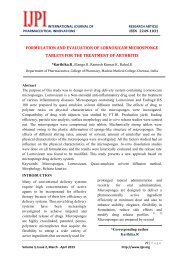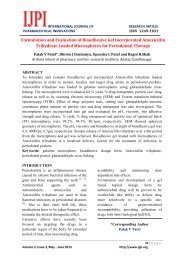6. present and future of pharma education and pharmacy ... - IJPI
6. present and future of pharma education and pharmacy ... - IJPI
6. present and future of pharma education and pharmacy ... - IJPI
You also want an ePaper? Increase the reach of your titles
YUMPU automatically turns print PDFs into web optimized ePapers that Google loves.
INTERNATIONAL JOURNAL OF<br />
REVIEW ARTICLE<br />
PHARMACEUTICAL INNOVATIONS ISSN 2249-1031<br />
PRESENT AND FUTURE OF PHARMA EDUCATION AND<br />
PHARMACY PROFESSION IN INDIA<br />
Patel R*, Mangal A, Koshta A, Bhadoriya S S,<br />
Department <strong>of</strong> Pharmacy Practices, Vikrant Institute <strong>of</strong> Pharmacy, Indore,India.<br />
ABSTRACT:<br />
The beginning <strong>of</strong> Pharmaceutical <strong>education</strong> in India was initiated at the Banaras Hindu<br />
University way back in 1932 by Pr<strong>of</strong>essor M.L.Schr<strong>of</strong>. It is a well-known fact that, the two<br />
Pharma <strong>education</strong>-governing bodies namely PCI <strong>and</strong> AICTE generally have a conflicting<br />
approach towards the changes that are required by the system. Not being entirely successful<br />
at the tasks set to them under respective acts, they need reorientation. There is a growing need<br />
for the two to work together towards the development <strong>of</strong> the Pharmacy <strong>education</strong> system. The<br />
dem<strong>and</strong>s <strong>of</strong> the competitive world need to be reconsidered by them for regulating <strong>and</strong><br />
maintaining the norms <strong>and</strong> st<strong>and</strong>ards <strong>of</strong> the <strong>education</strong> system. The primary purpose <strong>of</strong><br />
<strong>pharma</strong>cy <strong>education</strong> is to develop technical human resources, novel approach <strong>and</strong> vision with<br />
respect to teaching, research <strong>and</strong> development <strong>and</strong> training <strong>future</strong> health care pr<strong>of</strong>essionals in<br />
the field <strong>of</strong> drugs <strong>and</strong> <strong>pharma</strong>ceuticals. This article shows the <strong>present</strong> <strong>and</strong> <strong>future</strong> <strong>of</strong> <strong>pharma</strong><br />
<strong>education</strong> <strong>and</strong> <strong>pharma</strong>cy pr<strong>of</strong>ession in India.<br />
KEYWORDS: Pharma Education Present, Future <strong>and</strong> Pr<strong>of</strong>ession<br />
INTRODUCTION<br />
Pharmacy <strong>education</strong> introduced in India in<br />
1937 by Pr<strong>of</strong> MM Malaviya <strong>and</strong> Pr<strong>of</strong> ML<br />
Schr<strong>of</strong>f in BHU has undergone dramatic<br />
changes over the past few decades but yet<br />
nowhere near the international st<strong>and</strong>ards.<br />
In India, the pr<strong>of</strong>ession <strong>of</strong> <strong>pharma</strong>cy is still<br />
in its developing stages <strong>and</strong> is yet to bloom<br />
to its fullest extent. It covers opportunities<br />
in <strong>pharma</strong>ceutical industry – research &<br />
development, manufacturing & retail,<br />
healthcare sector, <strong>pharma</strong>cy <strong>education</strong>, <strong>and</strong><br />
regulatory bodies. The current availability<br />
<strong>of</strong> <strong>pharma</strong>cists in terms <strong>of</strong> <strong>pharma</strong>cist to<br />
population ratio compares favourably with<br />
that in developed country. However, the<br />
number <strong>of</strong> registered <strong>pharma</strong>cists does not<br />
reflect the actual number <strong>of</strong> <strong>pharma</strong>cists<br />
currently involved in <strong>pharma</strong>cy practice.<br />
Pharmacy <strong>education</strong> in India is largely<br />
industry oriented. Indian <strong>pharma</strong>ceutical<br />
industry with its tremendous growth<br />
capacity has several job opportunities.<br />
However, the graduates who pass out do<br />
not get employment easily due to their<br />
poor training, lack <strong>of</strong> in depth knowledge<br />
<strong>of</strong> fundamental concepts <strong>and</strong> practical<br />
skills. The quality <strong>of</strong> training provided<br />
during their <strong>education</strong> is inadequate. They<br />
require on job training <strong>of</strong> 6-18 months<br />
before they can match the requirements <strong>of</strong><br />
*Corresponding Author<br />
Patel R.<br />
Volume 2, Issue 5, Sep.− Oct. 2012<br />
64 | P a g e<br />
http://www.ijpi.org
INTERNATIONAL JOURNAL OF<br />
REVIEW ARTICLE<br />
PHARMACEUTICAL INNOVATIONS ISSN 2249-1031<br />
the industry. The role <strong>of</strong> Pharmacist is<br />
highly significant in the sustainable growth<br />
<strong>and</strong> health care system <strong>of</strong> the country.<br />
Here the <strong>pharma</strong>cist performs a job <strong>of</strong> a<br />
drug seller <strong>and</strong> does not practice the<br />
pr<strong>of</strong>ession independently <strong>and</strong> depends on a<br />
doctor who is the decision maker. To cater<br />
to these needs <strong>present</strong>ly, B. Pharm. & M.<br />
Pharm. is available <strong>and</strong> D. Pharm. being<br />
the minimum need. The community<br />
expects more pr<strong>of</strong>essional services from<br />
<strong>pharma</strong>cists <strong>and</strong> not as just drug sellers.<br />
The Pharmacy Council <strong>of</strong> India (PCI)<br />
defines Pharmacy as a pr<strong>of</strong>ession which is<br />
concerned with the art <strong>and</strong> science <strong>of</strong><br />
preparing from natural <strong>and</strong> synthetic<br />
sources, suitable <strong>and</strong> convenient materials<br />
for distribution <strong>and</strong> use in the treatment<br />
<strong>and</strong> prevention <strong>of</strong> disease. It embraces<br />
knowledge <strong>of</strong> the identification,<br />
preservation, combination, analysis <strong>and</strong><br />
st<strong>and</strong>ardization <strong>of</strong> drugs <strong>and</strong> medicines<br />
besides synthesis <strong>of</strong> new drug molecules,<br />
manufacturing <strong>of</strong> various dosage forms.<br />
All the operations in the pr<strong>of</strong>ession <strong>of</strong><br />
<strong>pharma</strong>cy, may it be industry, community<br />
or hospital have the lives <strong>of</strong> patients at the<br />
receiving end. Hence quality <strong>and</strong><br />
excellence are <strong>of</strong> paramount in this<br />
pr<strong>of</strong>ession. The course content <strong>of</strong> diploma<br />
or degree programmed provided in the<br />
country still does not cater to the above<br />
requirement. Very few institutes are<br />
providing such training where the<br />
<strong>pharma</strong>cist becomes directly involved in<br />
providing health care to the patients.<br />
PHARMA EDUCATION – PRESENT<br />
Pharmaceutical <strong>education</strong> plays a very<br />
prominent role in attaining sustainable <strong>and</strong><br />
equitable development <strong>of</strong> a country. The<br />
formal <strong>pharma</strong>cy <strong>education</strong> in India two<br />
Volume 2, Issue 5, Sep.− Oct. 2012<br />
year diploma, four year degree <strong>and</strong> two<br />
year master degree programme.<br />
Table I : Pharmacy Education in India<br />
Course Entry level Duration Regulation<br />
D. Pharm. 10+2 2¼ PCI<br />
B. Pharm. 10+2 4 AICTE, PCI<br />
M. Pharm. B. Pharm. 2 AICTE<br />
As per PCI 2010-2011 diary calendar, at<br />
least the total numbers <strong>of</strong> recognized<br />
degree institutions are 626 with intake<br />
something <strong>of</strong> 37560 students <strong>and</strong> as per<br />
AICTE 2010-2011 total numbers <strong>of</strong><br />
recognized degree institutions are 1102<br />
with intake <strong>of</strong> 103867 students. The<br />
growth <strong>of</strong> <strong>pharma</strong> <strong>education</strong> initiatives<br />
taken during successive five year plans.<br />
FUTURE OF PHARMA EDUCATION<br />
The spectrum <strong>of</strong> <strong>pharma</strong>cy pr<strong>of</strong>ession in<br />
India is very wide. So, PCI <strong>and</strong> AICTE<br />
needs to<br />
Strengthen the implementation <strong>of</strong> the<br />
monitoring mechanism for improving<br />
quality <strong>of</strong> <strong>education</strong> & training system in<br />
<strong>pharma</strong> programme such as,<br />
There exist a mechanism to<br />
regularly monitor the<br />
infrastructure, manpower <strong>and</strong> other<br />
critical inputs for delivering quality<br />
<strong>education</strong> <strong>and</strong> training,<br />
There exists a system <strong>of</strong> teachers<br />
training & skill enhancement to<br />
develop teaching faculty in the<br />
<strong>pharma</strong>cy sector.<br />
The quality <strong>of</strong> <strong>education</strong> <strong>and</strong> training in<br />
<strong>pharma</strong>cy institution can be effectively<br />
improved through accreditation. The<br />
process <strong>of</strong> accreditation helps in assuring<br />
65 | P a g e<br />
http://www.ijpi.org
INTERNATIONAL JOURNAL OF<br />
REVIEW ARTICLE<br />
PHARMACEUTICAL INNOVATIONS ISSN 2249-1031<br />
minimum quality in <strong>education</strong> <strong>and</strong><br />
training. Currently the <strong>pharma</strong>cy<br />
programmes (diploma, degree & post<br />
graduate programmes) are accredited by<br />
National Board <strong>of</strong> Accreditation (NBA)<br />
constituted by the AICTE. The PCI is<br />
exploring the option <strong>of</strong> tying up with the<br />
US Accreditation Council for Pharmacy<br />
Education (ACPE) with a view to help<br />
Indian Pharmacists get job openings in the<br />
US. The spin <strong>of</strong>f benefits <strong>of</strong> updating<br />
curriculum, training, <strong>and</strong> improving the<br />
quality <strong>of</strong> <strong>education</strong>, would also help<br />
recognition <strong>of</strong> Indian <strong>pharma</strong>cy <strong>education</strong><br />
in other countries <strong>of</strong> the world. Hope that<br />
the PCI controls <strong>and</strong> regulates the<br />
st<strong>and</strong>ards for a better <strong>pharma</strong>cy <strong>education</strong><br />
in India.<br />
PHARMACY PROFESSION IN INDIA<br />
The spectrum <strong>of</strong> <strong>pharma</strong>cy pr<strong>of</strong>ession in<br />
India is very wide. It covers opportunities<br />
in <strong>pharma</strong>ceutical industry –<br />
manufacturing & retail, healthcare sector,<br />
<strong>pharma</strong>cy <strong>education</strong>, <strong>and</strong> regulatory<br />
bodies. Currently there are over a million<br />
<strong>pharma</strong>cists in India with around 55% <strong>of</strong><br />
them in community, 20% in hospital, 10%<br />
in industry <strong>and</strong> regulatory <strong>and</strong> 2% in<br />
academia In India, While more than 98%<br />
<strong>of</strong> individuals with D.Pharm degree are<br />
mainly engaged in dispensing medicine at<br />
retail or hospital <strong>pharma</strong>cies, those with<br />
B.Pharm or higher degree have a variety <strong>of</strong><br />
opportunities to choose from. Some <strong>of</strong><br />
these areas are given in Table IV –<br />
CONCLUSION<br />
Over all ultimate analysis is that <strong>pharma</strong>cy<br />
pr<strong>of</strong>ession faces an acute need to maintain<br />
(change) the quality parameter in<br />
<strong>education</strong>al <strong>and</strong> training system for<br />
recognized st<strong>and</strong>ard. This change deliver<br />
the quality assured product to market for<br />
challenge the <strong>present</strong> Academia, R & D<br />
<strong>and</strong> Health care system.<br />
REFERENCES<br />
1. All India Council For Technical<br />
Education, Format & Guidelines,<br />
Industry-Institute partnership Cell.<br />
2. Azad AK. Pharmacy Education in<br />
Bangladesh: Past, Present <strong>and</strong><br />
Future, BAPA Convention, New<br />
York, August 8-9, 2008.<br />
3. Cited onhttp;//www.aicte.ernet.in/aicte/wha<br />
tsnew.html<br />
4. Higby G.J. American Pharmacy in<br />
Twentieth Century, Am.J. Health.<br />
Syst.Pharmacy 1997, 54, 1805.<br />
5. Industry institute Partnership ISTE-<br />
CIICP monograph series,<br />
Pr<strong>of</strong>.M.V.Rangnath.<br />
<strong>6.</strong> Kokate C.K., Pharmacy Education,<br />
Ind.J.Pharm.Edu. 1996,30,<br />
7. Lalla J.K., Pharmacy Education-<br />
Challenges ahead –My Perception,<br />
Ind.J.Pharm.Edu. 1999, 33, 24.<br />
8. M.D. Bur<strong>and</strong>e, Restructuring <strong>of</strong><br />
Pharmacy Education, Ind. J.Pharm.<br />
Edu. 1997, 31,103.<br />
9. N.Mukund, Academia-Industry gap<br />
in India curr. Sci. 2003, 84, 614<br />
10. Seth P.D Pharm-Education in the<br />
new millennium, Ind.J.Pharm.Edu.<br />
1999, 33, 93.<br />
Volume 2, Issue 5, Sep.− Oct. 2012<br />
66 | P a g e<br />
http://www.ijpi.org
Pharmacy Institutes<br />
INTERNATIONAL JOURNAL OF<br />
REVIEW ARTICLE<br />
PHARMACEUTICAL INNOVATIONS ISSN 2249-1031<br />
Table II : Growth <strong>of</strong> Pharma Institutions in Year Wise<br />
S.N. Year Pharmacy Institutes Added in Year<br />
01 2005-06 629 29<br />
02 2006-07 665 36<br />
03 2007-08 854 189<br />
04 2008-09 1021 167<br />
05 2009-10 1054 33<br />
06 2010-11 1102 48<br />
1200<br />
1000<br />
800<br />
600<br />
400<br />
200<br />
0<br />
Growth <strong>of</strong> Pharma Institutions in Year Wise<br />
2005-06 2006-07 2007-08 2008-09 2009-10 2010-11<br />
Year<br />
Fig 1: Growth <strong>of</strong> Pharma Institutions in Year Wise<br />
Table III: Growth <strong>of</strong> Seats in Pharma in Year wise<br />
S.N. Year Seats Added in Year<br />
01 2005-06 32708 4680<br />
02 2006-07 39517 6809<br />
03 2007-08 52334 12817<br />
04 2008-09 64211 11877<br />
05 2009-10 72836 8625<br />
06 2010-11 103867 31031<br />
Volume 2, Issue 5, Sep.− Oct. 2012<br />
67 | P a g e<br />
http://www.ijpi.org
Seats<br />
INTERNATIONAL JOURNAL OF<br />
REVIEW ARTICLE<br />
PHARMACEUTICAL INNOVATIONS ISSN 2249-1031<br />
120000<br />
Growth <strong>of</strong> Seats in Pharma Institutions in Year Wise<br />
100000<br />
80000<br />
60000<br />
40000<br />
20000<br />
0<br />
2005-06 2006-07 2007-08 2008-09 2009-10 2010-11<br />
Year<br />
Fig 2: Growth <strong>of</strong> Seats in Pharma in Year wise<br />
Table IV: Career Options for Pharmacists<br />
Research &<br />
Development<br />
Production & Manufacturing Marketing Retail &Hospital<br />
Pharmacy<br />
Chemist/Chemical<br />
Engineer/Pharmacologist:<br />
In new drug discovery,<br />
Process development,<br />
F&D,Clinical Trials,<br />
Production &Analytical<br />
Chemist/Q.C.Chemist/Q.A.Officer<br />
Marketing Exec.-<br />
M.R. involve in<br />
<strong>pharma</strong> sales &<br />
supply.<br />
Retail &Hospital<br />
Pharmacist<br />
involve in<br />
dispensing &<br />
store magt.<br />
Bioequivivalance<br />
study,Toxicological study,<br />
anlytical testing<br />
Academic :Faculty in <strong>pharma</strong>cy institute involve in teaching,<br />
training & research<br />
Regulatory: In Govt. &Private sector<br />
involve in DRA,IPR such as copy<br />
right, trademarks etc.<br />
Volume 2, Issue 5, Sep.− Oct. 2012<br />
68 | P a g e<br />
http://www.ijpi.org
















